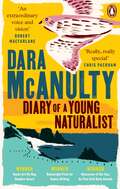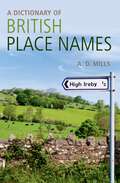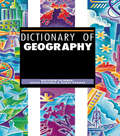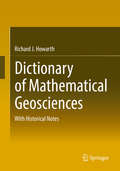- Table View
- List View
Diamonds in Nature: A Guide to Rough Diamonds
by Ralf Tappert Michelle C. TappertDiamonds in Nature: A Guide to Rough Diamonds illustrates the range of crystal shapes, colours, surface textures, and mineral inclusions of rough, uncut, naturally forming diamonds. Each chapter contains photographs that show the unique physical characteristics of the diamonds, and the accompanying text describes the processes that led to their formation. This book is an invaluable reference manual for professional geoscientists—including gemmologists and exploration geologists.
The Diaries of a Bonedigger: Harold Rollin Wanless in the White River Badlands of South Dakota, 1920–1922
by Harold Rogers Wanless Emmett EvanoffThrough the original writings and photography of renowned geologist Harold Rollin Wanless, this book paints a thorough and engaging picture of the White River Badlands’ landscape, geology, biology, pioneer settlers, and how life was lived 100 years ago in a harsh, challenging, remote setting. In the summer of 1920, Harold Rollin Wanless, fresh from an undergraduate geology degree at Princeton, spent the first of three summers in the Badlands of South Dakota camping, hiking, and collecting fossil vertebrate skulls. Harold produced a fascinating and thorough diary and report, illustrated with over 100 image plates, in which he explains the geology, biology, and climate of this famous area. Wanless became deeply involved with and vividly records the life, hopes, trials and character of the new homesteading pioneers of the area, and the people and livelihoods he encountered are reflected in the diary as well. This is an engaging look at the history, environment, people and geological character of a unique portion of the American West. Combining a first-hand look at the White River Badlands and its people a century ago with the fossil history contained in its Cenozoic sediments gives a well-rounded historical presentation. This diary was found, compiled, and edited by Drs. Harold Rogers Wanless (the diarist’s son and an accomplished geologist himself) and Emmett Evanoff. In the introductory and concluding chapters of this book, they provide a broader perspective of Harold Rollin Wanless’s life and his significant achievements beyond the Badlands venture described here. In addition, this narrative - written “only” a century ago - provides a stark contrast with how we travel, communicate, conduct research and survive today, yet shows that human curiosity and kindnesses have not changed.
Diary of a Young Naturalist: Winner of the Wainwright Prize for Nature Writing 2020
by Dara McAnultyWINNER OF THE 2020 WAINWRIGHT PRIZE FOR NATURE WRITINGWINNER OF THE AN POST IRISH BOOK AWARD FOR NEWCOMER OF THE YEAR 2020WINNER OF THE BOOKS ARE MY BAG READERS AWARDS FOR NON-FICTION 2020SHORTLISTED FOR WATERSTONES BOOK OF THE YEAR 2020LONGLISTED FOR THE BAILLIE GIFFORD PRIZE 2020'Really, really special' CHRIS PACKHAM'An extraordinary voice and vision' ROBERT MACFARLANEDiary of a Young Naturalist chronicles the turning of Dara McAnulty's world, from spring to summer, autumn to winter, on his home patch, at school, in the wild and in his head. Evocative, raw and beautifully written, this startling and special book vividly explores the natural world from the perspective of an autistic teenager coping with the uprooting of home, school, and his mental health, while pursuing his life as a conservationist and environmental activist. In a work of power and hope, Dara recalls his sensory encounters in the wild - with blackbirds, whooper swans, red kites, hen harriers, frogs, dandelions, Irish hares and more - while drawing a moving portrait of a young activist dealing with change, and a family making their way in the world.'One of the most talented and passionate writers of our era' STEVE SILBERMAN
Dictionary and Introduction to Global Environmental Governance
by Richard A Meganck Richard E SaunierThis unique dictionary and introduction to Global Environmental Governance (GEG), written and compiled by two veterans of the international stage, provides a compilation of over 5500 terms, organizations and acronyms, drawn from hundreds of official sources. An introductory essay frames the major issues in GEG and outlines the pitfalls of talking past one another when discussing the most critical of issues facing the planet. It challenges those who are concerned with the management of our planet and its inhabitants to understand and accept a vocabulary common to the often-opposing objectives sought in the many GEG instruments. The result is a practical tool that should find a central place on the desk of anyone involved in environmental management, development or sustainability issues anywhere in the world, including the United Nations, government policy makers, NGOs and other stakeholder groups, the business community, and students and professionals. This fully revised and updated edition contains over 500 new entries and acronyms on global environmental governance as well a new introductory section on global water governance, one of the most pressing environmental issues in our era of climate change, growing populations and food shortages. Praise for the first edition:
Dictionary and Introduction to Global Environmental Governance
by Richard A Meganck Richard E SaunierThis unique dictionary and introduction to Global Environmental Governance (GEG), written and compiled by two veterans of the international stage, provides a compilation of over 5500 terms, organizations and acronyms, drawn from hundreds of official sources. An introductory essay frames the major issues in GEG and outlines the pitfalls of talking past one another when discussing the most critical of issues facing the planet. It challenges those who are concerned with the management of our planet and its inhabitants to understand and accept a vocabulary common to the often-opposing objectives sought in the many GEG instruments. The result is a practical tool that should find a central place on the desk of anyone involved in environmental management, development or sustainability issues anywhere in the world, including the United Nations, government policy makers, NGOs and other stakeholder groups, the business community, and students and professionals. This fully revised and updated edition contains over 500 new entries and acronyms on global environmental governance as well a new introductory section on global water governance, one of the most pressing environmental issues in our era of climate change, growing populations and food shortages. Praise for the first edition:
Dictionary Geotechnical Engineering / Wörterbuch GeoTechnik: Volume I: English · German / Band I: Englisch · Deutsch
by Herbert BuckschTogether, the two volumes of the Dictionary of Geotechnical Engineering (G-E, E-G) contain some 60,000 entries, with common synonyms given in the target language, where available. Similarly, additional explanations help to differentiate the headwords. Apart from general terms used in geology, the dictionary covers the more practical fields within geosciences, the emphasis being placed on mining, soil analysis, reconnaissance geology, geophysics, geomorphology, civil engineering, hydrogeology, hydraulic engineering, geological engineering, cartography, soil deposits, mineralogy, oceanography and surveying.
A Dictionary of British Place-Names (Oxford Quick Reference)
by A. D. MillsThis revised edition of the Dictionary of British Place-Names includes over 17,000 engaging and informative entries, tracing the development of the featured place-names from earliest times to the present day. Included place-names range from the familiar to the obscure, among them 'Beer', 'Findlater', 'Broadbottom', and 'Great Snoring'. The A to Z entries are complemented by a detailed introductory essay discussing the chronology and development of English, Irish, Welsh, and Scottish place-names, as well as an extensive bibliography, maps of Britain showing old and new boundaries, and a glossary of common elements in place-names. Also new to this edition is an appendix of recommended web links pointing to relevant online resources, thereby expanding the scope of the dictionary and providing the reader with an opportunity to explore the subject further. Both accessible and up to date, this dictionary is an ideal companion for anybody travelling around the British Isles, as well as for researchers and students with an interest in toponomy, local history, cartography, and lexicography.
A Dictionary of British Place-Names (Oxford Quick Reference)
This revised edition of the Dictionary of British Place-Names includes over 17,000 engaging and informative entries, tracing the development of the featured place-names from earliest times to the present day. Included place-names range from the familiar to the obscure, among them 'Beer', 'Findlater', 'Broadbottom', and 'Great Snoring'. The A to Z entries are complemented by a detailed introductory essay discussing the chronology and development of English, Irish, Welsh, and Scottish place-names, as well as an extensive bibliography, maps of Britain showing old and new boundaries, and a glossary of common elements in place-names. Also new to this edition is an appendix of recommended web links pointing to relevant online resources, thereby expanding the scope of the dictionary and providing the reader with an opportunity to explore the subject further. Both accessible and up to date, this dictionary is an ideal companion for anybody travelling around the British Isles, as well as for researchers and students with an interest in toponomy, local history, cartography, and lexicography.
Dictionary of Civil Engineering: English-French
by Jean-Paul KurtzI am pleased to present a work which marks a milestone in the history of public works and, more precisely, in that of permanent structures—a comprehensive dictionary of Civil Engineering terms. Since the beginning of time, Man has always tried to find a means to clear the obstacles which nature erected to displace him. With the first tree trunk thrown across a river, man sought to improve the crossing structure. After the invention of the wheel, and to satisfy his thirst for conquest (Roman ways), and comfort (aqueducts), man built bridges that became a preremptory necessity to move quickly. Thus, Man started to build wooden and masonry works. With the passing centuries, the builders became masters in the art of building masonry works. Then came the Industrial Revolution and the advent of the steel (1864), which was closely followed by the invention of the reinforced concrete (1855). The need for railways and improving the road network inspired great works of crossing such as viaducts and tunnels. The boom of the railway network and the development of the car required the construction of an increasing number of new structures. This phenomenon continues today with hundreds of structures built each year throughout the world.
Dictionary of Ecological Economics: Terms for the New Millennium
This comprehensive Dictionary brings together an extensive range of definitive terms in ecological economics. Assembling contributions from distinguished scholars, it provides an intellectual map to this evolving subject ranging from the practical to the philosophical. Following an insightful review of the intellectual and organisational origins of this topic by Joan Martínez-Alier, over 1,100 terms are thoroughly defined with their meanings and uses in ecological economics explained. In addition, most of the terms include recommendations for further reading to provide greater context and understanding, alongside citations to allow for further illustration on how a term is used in the field. Encompassing a broad overview of the field, this Dictionary will be a useful reference for students at all levels, alongside faculty and researchers. It will also be an informative resource for government and NGO professionals in environmental conservation to better understand the crucial vocabulary that governs their field.
Dictionary of Gems and Gemology
by Mohsen Manutchehr-DanaiThe rapid growth of gemological sciences and mineralogy demands a dictionary such as this for gemologists, mineralogists, geologists, jewel dealers, industry and hobbyists. With some 16,000 comprehensive definitions, supplemented by more than 250 diagrams and figures, this is a one-stop reference to any matter dealing with gems and gemology.
A Dictionary of Geography (Oxford Quick Reference)
by Susan MayhewThis bestselling dictionary contains over 3,000 entries on both physical and human geography, covering topics such as cartography, surveying, meteorology, climatology, ecology, population, industry, and development. Over 70 diagrams complement the text, and many entries include worked examples. This edition has been fully revised and updated, and many entries are accompanied by useful web links which can be accessed on the dedicated companion website. This A-Z reference is clear, concise, and authoritative, and is an essential companion for all students and teachers of geography.
A Dictionary of Geography
by F. J. MonkhouseThe geographer seeks to describe the diverse features of the earth's surface, to explain if possible how these features have come to be what they are, and to discuss how they influence the distribution of man with his diverse activities. Geography therefore stands transitionally yet centrally between the natural sciences, the social studies, and the humanities. While in its concept and content it is an integrated whole, of necessity it impinges on the associated disciplines, and inevitably makes use of a wide range of kindred terminology. In compiling the 3,400 entries for this dictionary, the main criterion for inclusion has been usage. Geographical textbooks and periodicals have been systematically combed, and where a term has been used in a specific geographical context, or in a specialist sense which differs from general practice or popular usage, it has been included. Foreign words are listed where they have been accepted into English geographical literature, especially where no satisfactory translation exists. Cross-references are freely given, printed in small capitals, where it is necessary to assist the user in tracing cognate and supplementary entries, or where the meaning of the word thus shown is essential to the understanding of the entry. The emphasis throughout is on specific factual information, conveniently accessible on a strict alphabetical basis, rather than a bare definition. Statistical material and formulae are appended, where it would seem helpful, in the form of tables under the relevant entries. Since this dictionary is neither a gazetteer nor a compendium of current affairs, lists of countries and capitals, regional names and international groupings are not included, since these can be found conveniently elsewhere. The five hundred and seventy-two additional entries to this dictionary, together with a few minor modifications to the existing material, are the result of extensive correspondence and discussion since the appearance of the firs
A Dictionary of Geography
by F. J. MonkhouseThe geographer seeks to describe the diverse features of the earth's surface, to explain if possible how these features have come to be what they are, and to discuss how they influence the distribution of man with his diverse activities. Geography therefore stands transitionally yet centrally between the natural sciences, the social studies, and the humanities. While in its concept and content it is an integrated whole, of necessity it impinges on the associated disciplines, and inevitably makes use of a wide range of kindred terminology. In compiling the 3,400 entries for this dictionary, the main criterion for inclusion has been usage. Geographical textbooks and periodicals have been systematically combed, and where a term has been used in a specific geographical context, or in a specialist sense which differs from general practice or popular usage, it has been included. Foreign words are listed where they have been accepted into English geographical literature, especially where no satisfactory translation exists. Cross-references are freely given, printed in small capitals, where it is necessary to assist the user in tracing cognate and supplementary entries, or where the meaning of the word thus shown is essential to the understanding of the entry. The emphasis throughout is on specific factual information, conveniently accessible on a strict alphabetical basis, rather than a bare definition. Statistical material and formulae are appended, where it would seem helpful, in the form of tables under the relevant entries. Since this dictionary is neither a gazetteer nor a compendium of current affairs, lists of countries and capitals, regional names and international groupings are not included, since these can be found conveniently elsewhere. The five hundred and seventy-two additional entries to this dictionary, together with a few minor modifications to the existing material, are the result of extensive correspondence and discussion since the appearance of the firs
Dictionary of Geography
by Malcolm Skinner David Redfern Geoff FarmerFirst Published in 1999. Routledge is an imprint of Taylor & Francis, an informa company.
Dictionary of Geography
by Malcolm Skinner David Redfern Geoff FarmerFirst Published in 1999. Routledge is an imprint of Taylor & Francis, an informa company.
A Dictionary of Geology and Earth Sciences (Oxford Quick Reference)
by Michael AllabyThis new edition includes 10,000 entries which cover all areas of geoscience, including planetary science, oceanography, palaeontology, mineralogy and volcanology. In this edition, 675 new entries have been added, and include expanded coverage of planetary geology and earth-observing-satellites. Other new entries terms such as Ianammox, Boomerangian, earth rheological layering, and metamorphic rock classification. The entries are also complemented by more than 130 diagrams and numerous web links that are listed on a regularly updated dedicated companion website. Appendices supplement the A-Z and have been extended to include three new tables on the Torino Impact Hazard Scale, Avalanche Classes, and the Volcanic Explosivity Index. The list of satellite missions has also been revised and updated to include recent developments. A Dictionary of Geology and Earth Sciences is an authoritative, and jargon-free resource for students of geology, geography, geosciences, physical science, and those in related disciplines.
Dictionary of Global Climate Change
by W. John MaunderClimate, climate change, climate fluctuations and climatic trends are only a few of the terms used today, in not only conferences, scientific symposia and workshops, but also parliaments and in discussions throughout society. climatologists these terms may be well known; to the vast majority of people, however, they are new, and they require definition and explanation. The World Meteorological Organization inherited an interest and involvement in the studies of climate and climate change from its predecessor, the International Meteorological Organization (IMO), which was established in 1873. By 1929 the had set up a Commission for Climatology to deal with matters related to climate studies. When, in 1950, the World Meteorological Organization assumed the mantle of the it retained the commission which, among other responsibilities, had already recognized the need for the definition and explanation of terms used in climatology. It must also be said that much of what we now know about climate derives from the scientific and technical programmes - ordinated by and now, to a much greater extent, by In 1979, the First World Climate Conference made an assessment of the status of knowledge of climate and climate variability, and recommended the establishment of a World Climate Programme.
Dictionary of Mathematical Geosciences: With Historical Notes
by Richard J. HowarthThis dictionary includes a number of mathematical, statistical and computing terms and their definitions to assist geoscientists and provide guidance on the methods and terminology encountered in the literature. Each technical term used in the explanations can be found in the dictionary which also includes explanations of basics, such as trigonometric functions and logarithms. There are also citations from the relevant literature to show the term’s first use in mathematics, statistics, etc. and its subsequent usage in geosciences.
Dictionary of Minor Planet Names: Addendum to 6th Edition: 2012-2014
by Lutz D. SchmadelThe quantity of numbered minor planets is now approaching half a million. Together with this Addendum, the sixth edition of the Dictionary of Minor Planet Names, which is the IAU's official reference for the field, now covers more than 19,000 named minor planets. In addition to being of practical value for identification purposes, the Dictionary of Minor Planet Names provides authoritative information about the basis for the rich and colorful variety of ingenious names, from heavenly goddesses to artists, from scientists to Nobel laureates, from historical or political figures to ordinary women and men, from mountains to buildings, as well as a variety of compound terms and curiosities. This Addendum to the 6th edition of the Dictionary of Minor Planet Names adds approximately 2200 entries. It also contains many corrections, revisions and updates to the entries published in earlier editions. This work is an abundant source of information for anyone interested in minor planets and who enjoys reading about the people and things minor planets commemorate.
Dictionary of Minor Planet Names
by Lutz D. SchmadelThe quantity of numbered minor planets has now well exceeded a quarter million. The new sixth edition of the Dictionary of Minor Planet Names, which is the IAU’s official reference work for the field, now covers more than 17,000 named minor planets. In addition to being of practical value for identification purposes, the Dictionary of Minor Planet Names provides authoritative information on the basis of the rich and colorful variety of ingenious names, from heavenly goddesses to artists, from scientists to Nobel laureates, from historical or political figures to ordinary women and men, from mountains to buildings, as well as a variety of compound terms and curiosities.This sixth edition of the Dictionary of Minor Planet Names has grown by more than 7,000 entries compared to the fifth edition and by more than 2,000 compared to the fifth edition, including its two addenda published in 2006 and 2009. In addition, there are many corrections, revisions and updates to the entries published in earlier editions. This work is an abundant source of information for anyone interested in minor planets and who enjoys reading about the people and things minor planets commemorate.
Dictionary of Minor Planet Names: Addendum to Fifth Edition: 2006 - 2008
by Lutz D. SchmadelThe history and rapid development of minor planet dis In addition to citing the bibliographic source of the nam coveries constitute a fascinating story and one with a ing, we also provide the source of numbering. A spe rather breathtaking evolution. By October 2005, the cial concordance list will enable the evaluation of the total of numbered planets exceeded the remarkable cor respective publication dates. The complete work is, nerstone of 100,000 objects and only three years later of course, a thoroughly revised and considerably en in November 2008 we are even faced with minor planet larged data collection and every e?ort has been made ( ) 200000 . This dramatic evolution must be compared to check and correct each single piece of information ( ) with the huge time span of two centuries 1801–2000 again. For even more detailed information on the dis that was necessary to detect and to re?ne the orbits of covery circumstances of numbered but unnamed plan only the ?rst 20,000 minor planets. Nowadays, we need ets, the reader is referred to the extensive data ?les even less than 13 months for the same quantity! At the compiled by the Minor Planet Center. end of 2005, we had achieved a total of 12,804 named ( According to a resolution of IAU Division III 2000, minor planets a fraction of less than 11 per cent of ) Manchester IAU General Assembly DMPN attained all numbered minor planets.
Dictionary of Minor Planet Names
by Lutz D. SchmadelAccording to a long-standing astronomical tradition, the naming of minor planets in the solar system is the privilege of the discoverers. Contrary to most other kinds of celestial objects which receive complex alpha-numerical designations, the names of minor planets often say more about the discoverers than about the object in question. There is a rich and colourful variety of ingenious names, from those of heavenly goddesses in the nineteenth century, to the more prosaic and sometimes very specific names of observatories, towns and mountains, computers and persons, given by present-day discoverers. Commission 20 of the International Astronomical Union, under whose auspices the naming of minor planets falls, has long been concerned with the need to establish a complete catalogue of these names, as well as of the interpretation of their meanings. For this purpose, a Study Group on the Origin of Minor Planet Names was set up at the time of the IAU General Assembly in Baltimore in August 1988. The Working Group immediately started to collect information about these matters from all available sources, including some earlier, incomplete compilations made in the U.S. and in Europe, and also by personal interaction with living discoverers of minor planets.




















